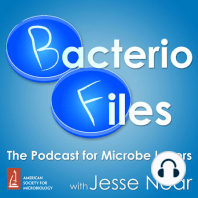9 min listen
401: Phototrophs Fill Fungal Filaments
FromBacterioFiles
ratings:
Length:
12 minutes
Released:
Nov 4, 2019
Format:
Podcast episode
Description
This episode: In this partnership between fungus and algae, the algae eventually take up residence inside their partner! Download Episode (8.4 MB, 12.1 minutes) Show notes: Microbe of the episode: Erwinia tracheiphila News item/Summary article Takeaways Partnerships and cooperation between otherwise free-living organisms is common in the natural world. Partnering with a photosynthetic organism is a smart approach, allowing the partner to get its energy from the sun and making gathering nutrients easier for the phototroph, and possibly offering protection as well. But in most partnerships, each partner stays separated by its own cell membrane. In this study, a fungus and an alga grow well together, exchanging carbon for nitrogen, similar to how lichens operate. But after a month or so of co-culture, the algae apparently enter the cells of the fungus somehow and live inside it, happily growing and dividing, turning the fungus green. Journal Paper: Du Z-Y, Zienkiewicz K, Vande Pol N, Ostrom NE, Benning C, Bonito GM. 2019. Algal-fungal symbiosis leads to photosynthetic mycelium. eLife 8:e47815. Other interesting stories: Skin microbe transplants could produce healthier skin communities Algae took genes from bacteria to deal with harsh conditions Email questions or comments to bacteriofiles at gmail dot com. Thanks for listening! Subscribe: Apple Podcasts, Google Podcasts, Android, or RSS. Support the show at Patreon, or check out the show at Twitter or Facebook.
Released:
Nov 4, 2019
Format:
Podcast episode
Titles in the series (97)
400: Considering Consumables' Community Correlations: This episode: Figuring out how gut communities change with changes in diet! (6.1 MB, 8.8 minutes) Show notes: Microbe of the episode: Hepacivirus A Takeaways Diet can play a big role in our health. It's not a magic pill that can cure or... by BacterioFiles
